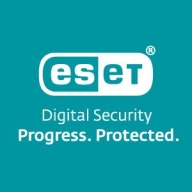

ESET Endpoint Protection Platform and Deep Instinct Prevention Platform are two prominent cybersecurity solutions. Deep Instinct has an edge with its advanced threat detection capabilities.
Features: ESET Endpoint Protection Platform is praised for its ease of use and regular updates. Users highlight its strong performance against malware and ransomware. Deep Instinct Prevention Platform is noted for its cutting-edge AI and machine learning capabilities that provide enhanced threat detection. The difference is that ESET focuses on traditional endpoint protection while Deep Instinct offers more advanced and proactive threat prevention.
Room for Improvement: ESET Endpoint Protection Platform users mention the need for better integration with other software and more intuitive reporting tools. Deep Instinct Prevention Platform users seek improvements in its speed and reduced false positives.
Ease of Deployment and Customer Service: ESET Endpoint Protection Platform is favored for its straightforward deployment process and responsive customer support. Deep Instinct Prevention Platform's deployment is seen as more complex, requiring specialized knowledge, but users appreciate the depth of support provided.
Pricing and ROI: ESET Endpoint Protection Platform users find the pricing reasonable for the features provided, with a satisfactory ROI. Deep Instinct Prevention Platform is considered more expensive, but users believe the advanced security capabilities justify the cost.
I saw the return on investment with ESET Endpoint Protection Platform within months.
Technical support from Deep Instinct Prevention Platform is fantastic.
Normally, I cannot give a ten for support of all brands, as it is not always possible to get full support from companies.
Their support is phenomenal, offering quick assistance.
In terms of scalability, I can rate it eight or nine out of ten.
In terms of stability, I can rate it at nine out of ten.
A lightweight version of ESET might be beneficial as many of our clients have older CPUs and RAM.
Extensive APIs to easily integrate our own systems with the platform for user configuration via their company portal.
ESET Endpoint Protection Platform sometimes makes the computer run slower and takes backup, which affects system performance.
The licensing is very competitively priced, better than all other solutions.
The pricing of ESET Endpoint Protection Platform is a bit high compared to other competitors.
I would rate ESET Endpoint Protection Platform a five for pricing on a scale from 1 to 10, where 1 is cheap and 10 is expensive.
Machine learning, especially through live detection, detects threats that are blocked based on reputation or sandbox detection.
The best feature of ESET Endpoint Protection Platform is that I get all the details about which user is using it, how much time they spend on websites, and all related information.
The primary purpose is to protect computers from viruses and ransomware.
| Product | Market Share (%) |
|---|---|
| ESET Endpoint Protection Platform | 3.0% |
| Deep Instinct Prevention Platform | 0.7% |
| Other | 96.3% |


| Company Size | Count |
|---|---|
| Small Business | 10 |
| Midsize Enterprise | 4 |
| Large Enterprise | 5 |
| Company Size | Count |
|---|---|
| Small Business | 67 |
| Midsize Enterprise | 17 |
| Large Enterprise | 21 |
Deep Instinct PREVENTS >99% of UNKNOWN threats like ransomware and zero-days before they land inside your environment – not after. With both an agentless and agent-based approach, we ensure file-based and fileless attacks are prevented. To achieve this, Deep Instinct is pioneering the use of deep learning AI to prevent threats in <20ms, without requiring calls to the cloud for threat intelligence. Our ability to scale to the needs of the enterprise is unprecedented as is our delivery of the industry’s lowest false positive rate of <0.1%.
The Deep Instinct Prevention Platform combines industry-leading static analysis based on the only deep learning framework dedicated to cybersecurity and includes two solutions:
To learn more, visit: https://www.deepinstinct.com.
ESET Endpoint Protection Platform (EPP) is a cybersecurity solution designed to protect businesses of all sizes against a wide array of cyber threats. Its advanced technologies and user-friendly interface provide robust security for endpoint devices, such as desktops, laptops, and mobile devices, without compromising performance. ESET's approach combines multiple layers of protection, including traditional signature-based detection with advanced heuristic analysis, behavioral monitoring, and machine learning, to effectively counter both known and emerging threats.
ESET's Endpoint Protection Platform is based on a multi-layered defense strategy, which utilizes various technologies like cloud-based scanning, network attack protection, and exploit blockers. This strategy ensures solid protection against malware, ransomware, phishing attacks, and advanced persistent threats (APTs), offering businesses peace of mind regarding their digital security. ESET's platform protects computers, mobile devices, file servers and virtual environments. It’s available as a standalone product and as a part of a wider enterprise cybersecurity bundle, ESET PROTECT Enterprise, which also includes file server security, disk encryption, a cloud sandbox and EDR.
ESET PROTECT Advanced
The ESET PROTECT Advanced provides best-in-class endpoint protection against ransomware & zero-day threats, backed by powerful data security.
Performance and Compatibility
ESET is widely acclaimed for its light system footprint, ensuring that endpoint protection does not come at the expense of performance. This efficiency is crucial for maintaining operational productivity without sacrificing security. Moreover, ESET's solutions are compatible with a wide range of operating systems, including Windows, macOS, Linux, and Android.
Centralized Management
ESET Endpoint Protection Platform is managed via ESET Security Management Center, a centralized management console that provides real-time visibility into on-premise and off-premise endpoints. This simplifies the administration of security policies, streamlines the detection and response processes, and provides detailed reporting capabilities, making it easier for IT professionals to maintain a secure and compliant IT environment.
We monitor all Endpoint Protection Platform (EPP) reviews to prevent fraudulent reviews and keep review quality high. We do not post reviews by company employees or direct competitors. We validate each review for authenticity via cross-reference with LinkedIn, and personal follow-up with the reviewer when necessary.